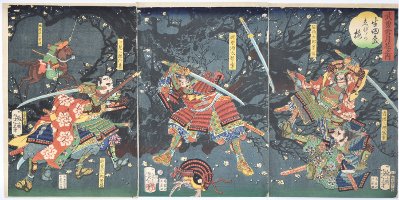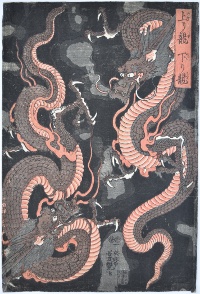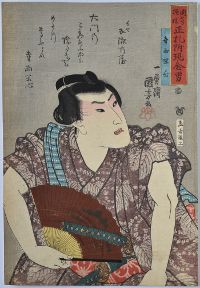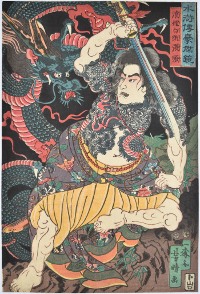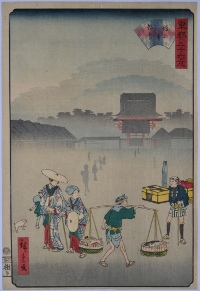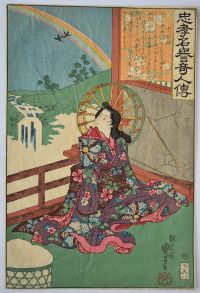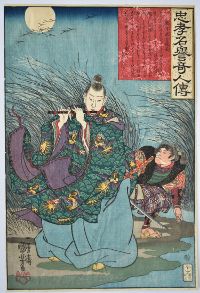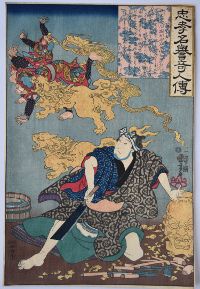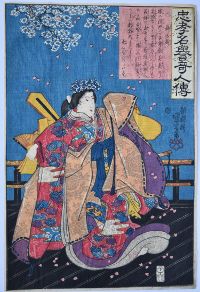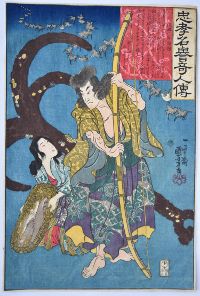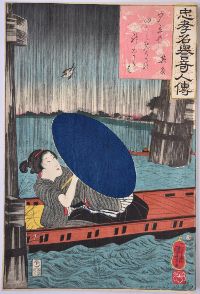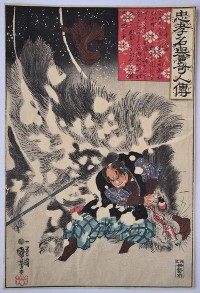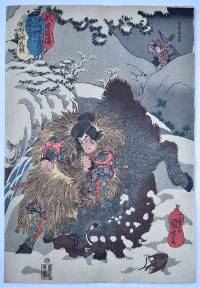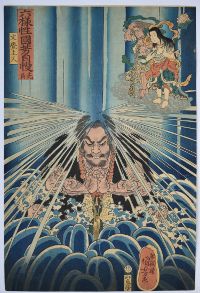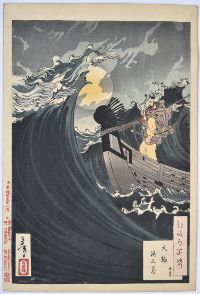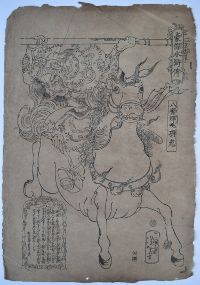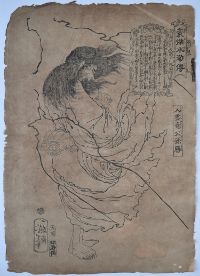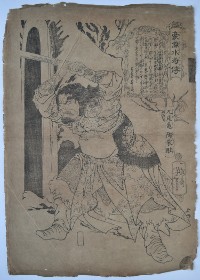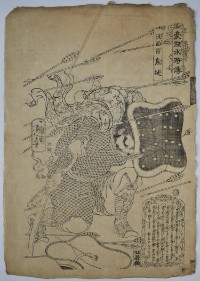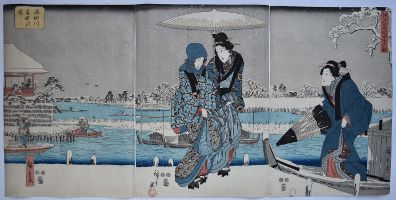/category/archive/page/16/
Tsukioka YOSHITOSHI (1839-1892)
Click here to view image full size.
A triptych from a set of three designs: Buyu setsugekka no uchi, “Snow, Moon and Flowers with Valiant Warriors,” this being “Flower”: Ikutamori ume, “Plum at Ikuta Forest.” The battle of Ichi-no-Tan took place in the forest between the Taira and Minamoto clans. Published by Kiya Sojiro, 2/1867.
Very good impression, colour and condition. Signed Ikkaisai Yoshitoshi hitsu
Status: Sold
Ichieisai YOSHITSUYA (1822-1866)
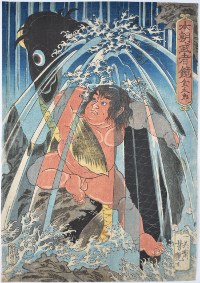
Click here to view image full size.
The young Kintaro, aka, Kintoki, Sakata Kaidomaru. He is shown fighting a giant carp in a waterfall from a series: Honcho musha kagami, Kintaro, “ Mirror of Warriors of Our Country, Kintaro.” This child of superhuman strength is often depicted with the animals living on Ashigara mountain where he honed his fighting skills and was spotted by Minamoto Yorimitsu (944-1021), under whom he went on to serve.Yoshitsuya was a pupil of Kuniyoshi and this print can be compared to a famous design by Kuniyoshi of the same subject published in 1836. Published by Tsujiokaya Bunsuke, 7/1856.
Very good impression and colour. Slight creasing, otherwise good condition. Signed Ichieisai Yoshitsuya ga.
Status: Sold
Ichieisai YOSHITSUYA (1822-1866)
Click here to view image full size.
An extremely rare print by this pupil of Kuniyoshi: Nobori ryu; kudari ryu, “Dragon going up [in the sky]; dragon going down [to the earth].” The most popular of Japanese subjects, printed in sumi and red. Published by Shimizuya Tsunejiro, 1849-50. This is the first time I have I catalogued this design.
Very good impression and colour. Minor creasing and slight adhesive mark at right edge. Signed Ichieisai Yoshitsuya ga.
Status: Sold
Utagawa KUNIYOSHI (1797-1861)
Click here to view image full size.
A bust portrait of Teranishi Kanshin holding a fan from the series Kuniyoshi moyo shofuda tsuketari genkin otoko, “ Men of Ready Money with True Labels Attached, Kuniyoshi Fashion.” The title derived from a contemporary kabuki play Shofuda tsuki kongen kusazuri. Poem above by Gosonoya of Ise. Robinson S40.7. Published by Ibaya Kyubei, 1845.
Fine impression and colour. Slight trimming and retains original album backing, otherwise fine condition. Signed Ichiyusai Kuniyoshi ga.
Status: Sold
Utagawa YOSHIHARU (1828-1888)
Click here to view image full size.
The brigand Rori Hakucho Chojun from the set Suikoden goketsu kagami, “Mirror of the Heroes of the Suikoden.” A set mirrored on Kuniyoshi’s earlier Suikoden set. Shows him, with heavily tattooed torso and wielding a sword, defending himself against a dragon. Published by Yamaguchiya Tobei, 1856.
Fine impression and colour. Slight trimming top and bottom, otherwise very good condition. Signed Ichibaisai Yoshiharu ga.
Status: Sold
Ichiyusai HIROSHIGE II (1829-1869)
Click here to view image full size.
Zojo-ji asagiri, “Morning Mist at Zojo Temple” from Toto sanjurokkei, “Thirty-six Views of the Eastern [ Edo ] Capital.” A couple watch a fish porter passing in the precincts of the Buddhist shrine . Situated in Shiba it was the Tokugawa family temple. The set published by Ai-To between 1861 and 1862 ( this being 6/1862 ). One of the six best designs from the set.
Fine impression of the first edition. Fine colour and condition. Signed Hiroshige ga.
Status: Sold
Yashima GAKUTEI (1786?-1868)
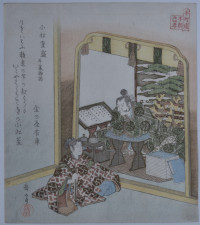
Click here to view image full size.
A surimono, Komatsu Shigemori, from the Heike Monogatari. One of a set with series title: Honchoren honcho nijushiko, “Twenty-four Japanese Paragons of Filial Piety for the Honcho Circle.” Issued by the Honchoren poetry club, c. 1821. Shows Taira no Kiyomori (1118-81) seated in an alcove being admonished by his son Shigemori (1138-79) for not being as loyal to the emperor as he had been. Kiyomori was a famous military leader and head of the Taira Clan. Poem by Kanenoya Arikado.
Fine impression, colour and condition with silver and gold. Signed Gakutei with Sadaoka seal.
Status: Sold
Utagawa TOYOKUNI II (1777-1835)
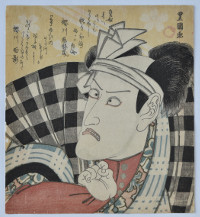
Click here to view image full size.
A surimono showing a bust portrait of the actor Ichikawa Danjuro VII as Kanawa no Goro, a retainer of Kamatari no Fujiwara, disguised as the fisherman Fukashichi from the Mikasayama Goten scene at the palace on Mount Mikasa in Act 4 of Imoseyama onna teikino. Three poems by Shoshokyo Otokado, Sakuragawa Jihinari and Sakuragawa Omokage. Issued c. mid 1820s. Rare.
Fine impression. Very good colour and condition. Signed Toyokuni ga.
Status: Sold
Yashima GAKUTEI (1786-1868)
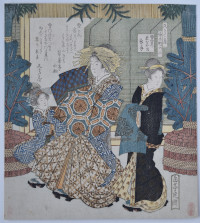
Click here to view image full size.
A surimono, Ni, Yukiwake no Wakanaya uchi Koromode, “Number Two: The Snow Clothes of Koromode of the Wakanaya” from the pentaptych entitled Hisakataya Nakanocho, “The Nakanocho for the Hisakataya Poetry Club.” Issued c. 1827. Shows the oiran Koromode of the Wakanaya parading with her Shinzo and another courtesan down the Nakanocho, the main street of the Yoshiwara. Two poems by Suihotei Komatsu and Hisakataya.
Fine impression, colour and condition with extensive gold and silver. Signed Gakutei Sadaoka.
Status: Sold
Katsushika TAITO II (Fl. c 1810-1850)
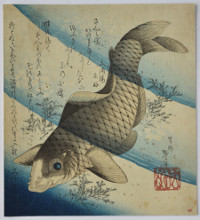
Click here to view image full size.
One of the great surimono designs and extremely rare: There appear to be four other genuine examples recorded, apart from this impression, which is from the Vever collection. (See Vever sale, Sothebys, 1977, lot 302. In fact, Vever had two copies. The other sold Vever sale, Sothebys, 1978, lot 231.) The Baur impression. See The Baur Collection, Matthi Forrer, Geneva, 1994, Volume 1, G224, and is also illustrated in the Chiba Museum catalogue, Ukiyo-e bino kiwami, 2001, no. 126. The Chester Beatty impression. See The Art of Surimono, Roger Keyes, Sothebys, 1985, vol. 2, no. 335, p. 384 (ex Gonse). And the MFA, Boston, impression, accession no. 11.20424, ex William Sturgis Bigelow. Three poems by Bunshuro Tomoyoshi, Bunkaro Kiyomaru, and Bumbunsha. Shows a carp swimming down amongst water-weeds and cherry blossom. The carp was a symbol of achievement against adversity in Japan and had a connotation with the new year. In fact, Taito designed another print of a carp amongst water-weeds which is part of a harimaze sheet and is most often encountered with the left calligraphy removed. Issued c 1832 for the Taikogawa Poetry Club. Vever seal bottom right.
Very fine impression with burnishing on the eye and the cherry blossom blind-printed. Fine colour. Minor foxing, otherwise very good condition. Signed Katsushika Taito.
Status: Sold
Totoya HOKKEI (1780-1850)
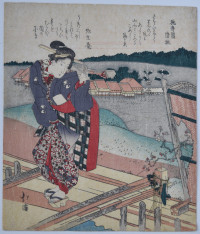
Click here to view image full size.
A surimono showing the poetess Kiyogaki standing on Mukaigaoka Hill overlooking a frozen Shinobazu Pond with the shrine of Benten. (And since the snake was the messenger of Benten, this print was probably issued for Snake Year 1833.) Two poems by Tojuen Kiyogaki and Yayoian.
Fine impression and colour with extensive silver – especially on the frozen lake. Slight soil, otherwise very good condition. Signed Hokkei.
Status: Sold
Totoya HOKKEI (1780-1850)
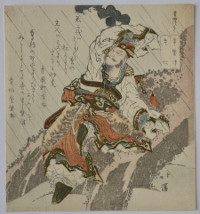
Click here to view image full size.
A surimono from a set Onkyoku zukushi, “An Array of Songs.” In the cartouche, top right, on the right, is Tokiwazu (a school of vocal music featuring the 3-stringed shamisen), and on the left the title of the musical piece illustrated here, which is Oimatsu, “Old Pine Tree,” a brief and auspicious piece composed in 1747 and used for celebratory occasions. A warrior is shown reclining against an old pine in heavy rain. Issued c 1818. Another from the set is illustrated in Reading Surimono, John Carpenter, Hotei publishing, 2008, no. 76, p. 203. Rare.
Fine impression with gold, blind-printing and the rain printed in silver. Very good colour. The red may be down slightly but, as yet, I have not found another impression to compare. Very good condition. Signed Hokkei.
Status: Sold
Yashima GAKUTEI (1786-1868)
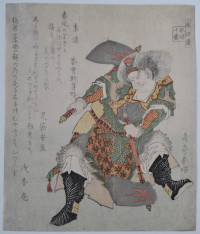
Click here to view image full size.
A surimono showing Li Kui (Jap: Ri Ki), one of the brigands from the One Hundred and Eight Heroes of the Popular Water Margin (the Suikoden). He was nicknamed the “Black Whirlwind” and is usually shown wielding two giant axes (as here). From a set Suiko Juban, “Ten Characters from the Water Margin.” Probably for the Kadonumaren Poetry Club c. late 1820s. Another two designs from the set are in the Harvard Art Museums, 1933.4.2003 and the Asian Art Museum, S.F., 2010.193. Rare: I cannot locate another impression at the moment.
Fine impression and colour. Slight soil and possibly slightly trimmed, otherwise very good condition. Extensive silver. Signed Gakutei Harunobu.
Status: Sold
Utagawa KUNIYOSHI (1797-1861)
Click here to view image full size.
Princess Chujo (Chujo-hime) from the set Chuko meiyo kijin den, “Stories of Remarkable Persons of Loyalty and High Reputation.” Published by Iseya Ichiemon or Enshuya Matabei (this design) 1845. Robinson S35.17. Abandoned by her stepmother, she is rescued by the nuns of Taima-dera, becomes a nun, and is credited with the invention of embroidery. She is shown here with a spinning wheel (forming a mandela around her head) and looking out at a landscape with a rainbow.
Very fine impression and colour. Very slight crinkling and trimmed close, otherwise fine condition. Signed Cho-o-ro Kuniyoshi ga.
Status: Sold
Utagawa KUNIYOSHI (1797-1861)
Click here to view image full size.
Fujiwara no Yasumasa from the set Chuko meiyo kijin den, “Stories of Remarkable Persons of Loyalty and High Reputation.” Published by Iseya Ichiemon or Enshuya Matabei (this design) 1845. Robinson S35.11. A renowned poet and flautist, he escapes being attacked by the robber Hakamadare Yasusuke who is mesmerized by the music.
Superb impression and colour. Very slight crinkling and trimmed close, otherwise fine condition. Signed Cho-o-ro Kuniyoshi ga.
Status: Sold
Utagawa KUNIYOSHI (1797-1861)
Click here to view image full size.
The sculptor Hidari Jingoro from the set Chuko meiyo kijin den, “Stories of Remarkable Persons of Loyalty and High Reputation.” Published by Iseya Ichiemon or Enshuya Matabei (this design) 1845. Robinson S35.2. Although possibly fictitious, there are nevertheless many sculptures around Japan attributed to him. So accomplished was he that his pieces often came to life, as here, where a dragon and two lions chase the pursuers of his Lord’s wife.
Superb impression and colour. Very slight crinkling and trimmed close, otherwise fine condition. Signed Ichiyusai Kuniyoshi ga.
Status: Sold
Utagawa KUNIYOSHI (1797-1861)
Click here to view image full size.
Shidzuka-gozen or Lady Shidzuka from the set Chuko meiyo kijin den, “Stories of Remarkable Persons of Loyalty and High Reputation.” Published by Iseya Ichiemon or Enshuya Matabei (this design) 1845. Robinson S35.12. She was a renowned 12th century shirabyoshi (court) dancer who achieved fame after 100 Buddhist monks and 99 other dancers failed to bring much needed rain.
Superb impression and colour. Very slight crinkling and trimmed close, otherwise fine condition. Signed Ichiyusai Kuniyoshi ga.
Status: Sold
Utagawa KUNIYOSHI (1797-1861)
Click here to view image full size.
Chinzei Hachiro Tametomo (aka Minamoto no Tametomo) from the set Chuko meiyo kijin den, “Stories of Remarkable Persons of Loyalty and High Reputation.” Published by Iseya Ichiemon or Enshuya Matabei (this design) 1845. Robinson S35.15. He was a renowned archer who was banished to Oshima in Izu and is shown here holding a huge bow made from a tree branch and looking down at a fisherwoman. A large anchor behind.
Superb impression and colour. Very slight crinkling and trimmed close, otherwise fine condition. Signed Ichiyusai Kuniyoshi ga.
Status: Sold
Utagawa KUNIYOSHI (1797-1861)
Click here to view image full size.
The poetess Kikaku from the set Chuko meiyo kijin den, “Stories of Remarkable Persons of Loyalty and High Reputation.” Published by Iseya Ichiemon or Enshuya Matabei (this design) 1845. Robinson S35.6. Shows the Tokugawa poetess sheltering beneath an umbrella in heavy rain in a boat floating under a bridge. A fine design.
Superb impression and colour. Very slight crinkling and trimmed close, otherwise fine condition. Signed Ichiyusai Kuniyoshi ga.
Status: Sold
Utagawa KUNIYOSHI (1797-1861)
Click here to view image full size.
The samurai Yamamoto Kansuke from the set Chuko meiyo kijin den, “Stories of Remarkable Persons of Loyalty and High Reputation.” Published by Iseya Ichiemon (this design) or Enshuya Matabei 1845. Robinson S35.16. One of Takeda Shingen’s most trusted 24 Generals. He is shown fighting a wild boar in deep snow. A fine design.
Very fine impression and colour. Very slight crinkling and trimmed close, otherwise fine condition. Signed Ichiyusai Kuniyoshi ga.
Status: Sold
Utagawa KUNIYOSHI (1797-1861)
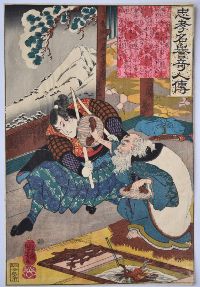
Click here to view image full size.
Miyamoto Musashi fencing with Tsukahara Bokuden from the set Chuko meiyo kijin den, “Stories of Remarkable Persons of Loyalty and High Reputation.” Published by Iseya Ichiemon (this design) or Enshuya Matabei 1845. Robinson S35.8. Tsukahara Bokuden was a famous swordsman (1489-1571). He is shown here parrying Musashi’s wooden swords with pot lids. Actually, Bokuden died 13 years before Musashi was born, so this is anecdotal.
Superb impression and colour. Very slight crinkling and trimmed close, otherwise fine condition. Signed Ichiyusai Kuniyoshi ga.
Status: Sold
Utagawa KUNIYOSHI (1797-1861)
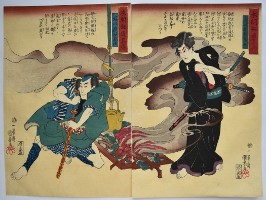
Click here to view image full size.
A complete diptych showing Inuyama Dosetsu Tadatomo with smoke curling around him and his hand on one of his swords facing Inugawa Sosuke Yoshito on one knee grasping his sword beside a wood fire from which the billowing smoke is emanating. Two of the heroes from Kyokutei Bakin’s famous book, Nanso Satomi hakkenden, “The Chronicles of the Eight Dog Heroes of the Satomi Clan of Nanso.” From a set of prints Kendo ryaku den “Abridged Stories of Our Country’s Swordsmamship.” Published by Kadzusa-ya Iwazo, c. 1845-6. The complete diptych is rare. Robinson S37.9.7.
Very fine impression, colour and condition. Signed Ichiyusai Kuniyoshi ga.
Status: Sold
Utagawa KUNIYOSHI (1797-1861)
Click here to view image full size.
Chinzei Hachiro Tametomo battling a large wild boar in the snowy mountains of Mashiki in the province of Higo, watched from above by Takama Harutsugu. A rare print from a rare unfinished (?) series Buyu hyaku den, “A Hundred Stories of Military Valour.” Published by Fujioka-ya Hikotaro, c. 1836.
Fine impression and colour. Slight fold, otherwise fine condition. Signed Ichiyusai Kuniyoshi ga.
Status: Sold
Utagawa KUNIYOSHI (1797-1861)
Click here to view image full size.
The priest Mongaku Shonin doing thirty-seven days’penance under the freezing Nachi waterfall near Kyoto. He is helped by Fudo Myo-o’s two attendants Seitaki and Kongara seen here top right. This act of self-mortification is because he accidentally killed his beloved cousin Kesa. Published by Uoya Eikichi, 1860. A fine design.
Very good impression, colour and condition. Signed Cho-o-ro Kuniyoshi ga.
Status: Sold
Utagawa KUNINAO (1793-1854)
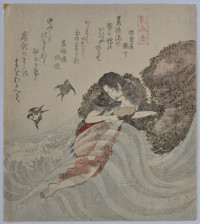
Click here to view image full size.
A surimono with series title Bijin awase, “Beautiful Women.” Shows a scantily clad diver emerging from waves holding an abalone shell and clinging to a rock. There are obvious erotic overtones to this wonderful surimono: Awabi divers were objects of great voyeuristic curiosity to the general public and feature in many aspects of Japanese art. Poems by Chinchoya Chincho and Jingoro Takumi. Provenance: Ex collection Louis Gonse, 1846-1921, who was a great collector of Japanese art and published L’Art Japonaise in 1883. Seal au verso. Very Rare: Other impressions are in the Chester Beatty Library, Dublin. See The Art of Surimono, Roger Keyes, 1985, no. 236, p. 267; MFA, Boston, RES.46.27; and illustrated in McKee, Colored in the Year’s New Light: Japanese Surimono From The Becker Collection, Cornell University, 2008, no. 112.
Fine impression and colour with silver printing to the waves. Evidence of mounting around edge au verso, otherwise fine condition. Artist’s seal Kuninao.
Status: Sold
Tsukioka YOSHITOSHI (1839-1892)
Click here to view image full size.
The best design from the set Tsuki hyakushi, the “Hundred Phases of the Moon.” The set published between 1885 and 1892 (this being 1886) by Akiyama Buemon. Shows Benkei on the prow of the ship in which Yoshitsune was forced to flee to northern Japan after being attacked by his half-brother Minamoto no Yoritomo. Sailing along the Inland Sea off the coast of Harima Province not far from Kyoto, the ship was struck by a storm in Daimotsu Bay caused by the vengeful ghosts of the Taira warriors Yoshitsune and his men had slain. Benkei pacified the spirits by holding up his string of prayer beads.
Fine impression and colour. Light album backing, otherwise very good condition. Signed Yoshitoshi.
Status: Sold
Tsukioka YOSHITOSHI (1839-1892)
Click here to view image full size.
A unique key-block proof of Happinata Kojo (Chin: Xiang Chong) riding into battle on his horse. This appears to be a proof for an unpublished print for the set Goketsu Suikoden, “Heroes of the Suikoden” published by Ohashi in 1868. Keyes lists just seven designs in this set. Aratame and date seal for 7/1868 and engraver’s seal Hori Wakasa. No publisher’s seal. The kento marks just visible. Browned and creased but commensurate with having survived. Sold “as is.” Signed Ikkaisai Yoshitoshi hitsu.
Status: Sold
Tsukioka YOSHITOSHI (1839-1892)
Click here to view image full size.
A key-block proof of Juunryu Kosonsho (Chin: Kun-sun Sheng) praying with lightning flashing around him. From the set Goketsu Suikoden, “Heroes of the Suikoden” published by Ohashi in 1868. Keyes lists just seven designs in this set. Aratame and date seal for 7/1868 and engraver’s seal Hori Wakasa. Publisher’s seal Ohashi (Daikyodo). One kento mark visible. Browned and creased but commensurate with having survived. Sold “as is.” Signed Ikkaisai Yoshitoshi hitsu.
Status: Sold
Tsukioka YOSHITOSHI (1839-1892)
Click here to view image full size.
A unique key-block proof of Kyubiki Toso-o (Chin: Tao Tsung-Wang) brandishing a sword. This appears to be a proof for an unpublished print for the set Goketsu Suikoden, “Heroes of the Suikoden” published by Ohashi in 1868. Keyes lists just seven designs in this set. Aratame and date seal for 7/1868. The outline for the engraver’s seal printed but the name not inserted. No publisher’s seal. The kento marks evident. Browned and creased but commensurate with having survived. Sold “as is.” Signed Ikkaisai Yoshitoshi hitsu.
Status: Sold
Tsukioka YOSHITOSHI (1839-1892)
Click here to view image full size.
A key-block proof of Botsumenmoku Shotei (Chin: Chiao Ting). From the set Goketsu Suikoden, “Heroes of the Suikoden” published by Ohashi in 1868. Keyes lists just seven designs in this set. Aratame and date seal for 8/1868 and engraver’s seal Hori Wakasa. Publisher’s seal Ohashi (Daikyodo). Kento marks visible. Some creasing but commensurate with having survived. Sold “as is.” Signed Ikkaisai Yoshitoshi hitsu.
Status: Sold
Ichiryusai HIROSHIGE (1797-1858)
Click here to view image full size.
Winter from a set of four triptychs: Edo meisho shiki-no nagame Sumidagawa setchu no zu, “Views of the Four Seasons at Famous Places in Edo, Snow on the Sumida River.” A famous print. Published by Marujin, 1848-9. Shows beauties and ferry boats on the river, a tea-house on the left.
Fine impression. Slight fading, otherwise very good colour. Very good condition. The block for the centre panel had vertical cracks in it from the very start. These striations are evident to the left and right of the figures and are on all impressions, becoming more evident on later pulls. Signed Hiroshige ga.
Status: Sold
Utagawa HIROSHIGE (1797-1858)
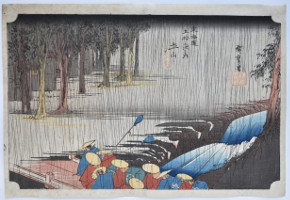
Click here to view image full size.
Tsuchiyama, haru no ame, “Tsuchiyama, Spring Rain.” Number 49 from the famous Tokaido gojusan tsugi no uchi, “The Fifty-three Stations of the Tokaido.” Published by Hoeido, c. 1833-4. Hiroshige travelled the length of the Tokaido as part of an official delegation in 1832 making sketches along the way. On his return he started work on the set eventually producing 55 prints. The first of the designs were published jointly by Hoeido and Senkakudo, but then Hoeido took over the production. Shows a daimyo’s cortege crossing the Tamura River. Tsuchiyama flourished because of its location at the entrance to the Suzuka Pass. However, in Meiji times, the town was bypassed by the railway because of the steep gradients here. This is the rare first edition.
Fine impression. Slight fading of seals, slight centre fold and minimal soil to left edge, otherwise very good condition. Signed Hiroshige ga.
Status: Sold
Utagawa HIROSHIGE (1797-1858)
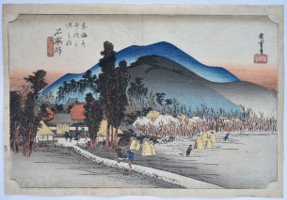
Click here to view image full size.
Ishiyakushi, number 44 from the Tokaido showing figures entering the village with others working in the fields. Ishiyakushi-ji Temple was seen on entering the village. From the famous Tokaido gojusan tsugi no uchi, “The Fifty-three Stations of the Tokaido.” Published by Hoeido, c. 1833-4. Hiroshige travelled the length of the Tokaido as part of an official delegation in 1832 making sketches along the way. On his return he started work on the set eventually producing 55 prints. The first of the designs were published jointly by Hoeido and Senkakudo, but then Hoeido took over the production. This is the rare first edition.
Fine impression. Slight fading of seals, slight centre fold and minimal soil to left edge, otherwise very good condition. Signed Hiroshige ga.
Status: Sold
Ichiryusai HIROSHIGE (1797-1858)
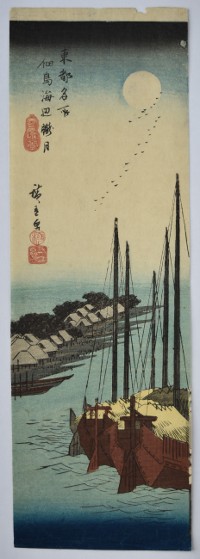
Click here to view image full size.
Spring moon at the shore of Tsukudajima. One of a set of chu-tanzaku prints published by Shogendo, c.1837. Tsukudajima was one of two islands at the mouth of the Sumida River. Originally a sandbar, it was reclaimed with earth and rocks and given its name by the first Tokugawa Shogun, Ieyasu, who invited thirty-three fishermen to live there in 1613 in order to provide fish for the rapidly expanding city of Edo. The fishermen came from Tsukudama near Osaka. And it was they who became the proprietors of what would become the Tsukiji fish market. It must have been popular during the late Edo period as a place to visit and view the boats from teahouses on the shore because there are many prints depicting the area, especially under a full moon.
Fine impression, colour and condition. Signed Hiroshige ga.
Status: Sold
Utagawa HIROSHIGE (1797-1858)
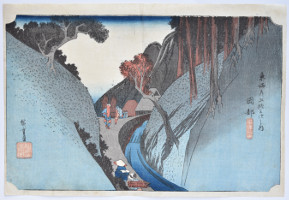
Click here to view image full size.
Okabe, Utsu no yama, “Okabe, Utsu Mountain.” Number 21 from the famous Tokaido gojusan tsugi no uchi, “The Fifty-three Stations of the Tokaido.” Published by Hoeido, c. 1833-4. Hiroshige travelled the length of the Tokaido as part of an official delegation in 1832 making sketches along the way. On his return he started work on the set eventually producing 55 prints. The first of the designs were published jointly by Hoeido and Senkakudo, but then Hoeido took over the production. Utsunoya Pass is just before Okabe. The pass is the scene of a Kabuki play by Mokuami Kawatake (1816-1893) where Jubei Itamiya kills and robs the blind Bun’ya. This is the rare first edition.
Fine impression. Slight fading of seals, slight centre fold and minimal soil to left edge, otherwise very good condition. Signed Hiroshige ga.
Status: Sold
Utagawa HIROSHIGE (1797-1858)
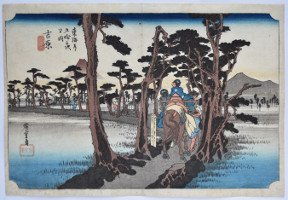
Click here to view image full size.
Yoshiwara, hidari Fuji, “Yoshiwara, Mount Fuji on the left.” Number 14 from the famous Tokaido gojusan tsugi no uchi, “The Fifty-three Stations of the Tokaido.” Published by Hoeido, c. 1833-4. Hiroshige travelled the length of the Tokaido as part of an official delegation in 1832 making sketches along the way. On his return he started work on the set eventually producing 55 prints. The first of the designs were published jointly by Hoeido and Senkakudo, but then Hoeido took over the production. After being destroyed by a tidal wave in 1680 Yoshiwara was rebuilt further inland from the sea. This is the rare first edition.
Fine impression. Slight fading of seals, slight centre fold and minimal soil to left edge, otherwise very good condition. Signed Hiroshige ga.
Status: Sold
Utagawa HIROSHIGE (1797-1858)
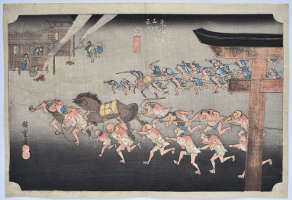
Click here to view image full size.
Miya, Atsuta shinji, “Miya, Festival of the Atsuta Shrine.” Number 41 from the famous Tokaido gojusan tsugi no uchi, “The Fifty-three Stations of the Tokaido.” Published by Hoeido, c. 1833-4. Hiroshige travelled the length of the Tokaido as part of an official delegation in 1832 making sketches along the way. On his return he started work on the set eventually producing 55 prints. The first of the designs were published jointly by Hoeido and Senkakudo, but then Hoeido took over the production. Miya was the largest station on the Tokaido. There were many inns catering for the pilgrims going to Ise and daimyo travelling to Edo. Shows the horse-driving festival held at the Shinto Atsuta Shrine, the Hama Gateway to the right. This is the rare first edition.
Fine impression. Slight fading of seals, slight centre fold and minimal soil to left edge, otherwise very good condition. Signed Hiroshige ga.
Status: Sold
Utagawa HIROSHIGE (1797-1858)
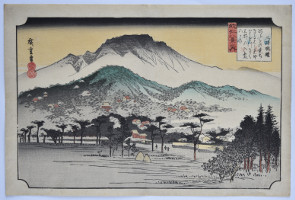
Click here to view image full size.
Mii no bansho, “Evening Bell at Miidera Temple” from an early set Omi hakkei no uchi, “Eight Views in Omi Province.” Shows the temple hidden amongst hills on the southern side of Lake Biwa. Miidera is the common name for the Onjoji, a temple of the Tendai sect, founded in 858. Published by Hoeido and Eikyudo in c. 1834-5. The “Eight Views” theme was derived (as so much else in Japanese art) from China and based on the Eight Views of Xiaoxiang paintings of the 11th century. The subject was transposed to Omi and then taken up by such artists as Harunobu , and later Hiroshige. It was also often playfully alluded to in sets of eight prints in mitate-e style.
Fine early impression and colour. Imperceptible centre fold, otherwise fine condition. Signed Hiroshige ga.
Status: Sold
Utagawa HIROSHIGE II (1829-1869)
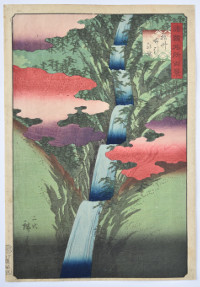
Click here to view image full size.
Sesshu Nunobiki no taki, “The Nunobiki Waterfall in Settsu Province,” from a set Shokoku meisho hyakkei, “One Hundred Famous Views in the Various Provinces.” The set published by Uoya Eikichi between 1859 and 1861 (this being 1859). He was the pupil of Hiroshige, given the name Shigenobu. After Hiroshige’s death he married his adopted daughter and became Hiroshige II. The couple were divorced in 1865. She went on to marry another pupil of her father’s – Shigemasa, who became Hiroshige III.
Superb impression and colour with extensive mica and woodgrain. Fine condition. Signed “The second” Hiroshige ga.
Status: Sold
Katsushika HOKUSAI (1760-1849)
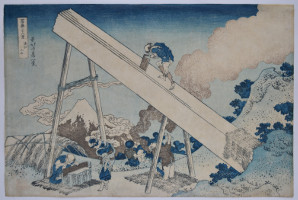
Click here to view image full size.
Totomi sanchu, “In the Totomi Mountains” from Hokusai’s most famous set Fugaku sanju-rokkei, “Thirty-six Views of Fuji.” The set published by Nishimuraya Yohachi c. 1830-33. Originally planned as a set of 36 prints, ten more designs were added. These are called the Ura-Fuji, “Fuji from the Other Side.” These designs have a black outline, while early impressions of the first 36 are printed with a blue outline changing to black on later editions. Shows lumbermen cutting a huge log while another, lower left, sharpens a saw watched by a woman with a child strapped to her back. This set was a considerable undertaking for the publisher, especially as the relatively new pigment berurin burau, “Berlin blue” was being used which was expensive.
Very good impression, colour and condition. Very full size. Signed Saki no Hokusai Iitsu hitsu.
Status: Sold
